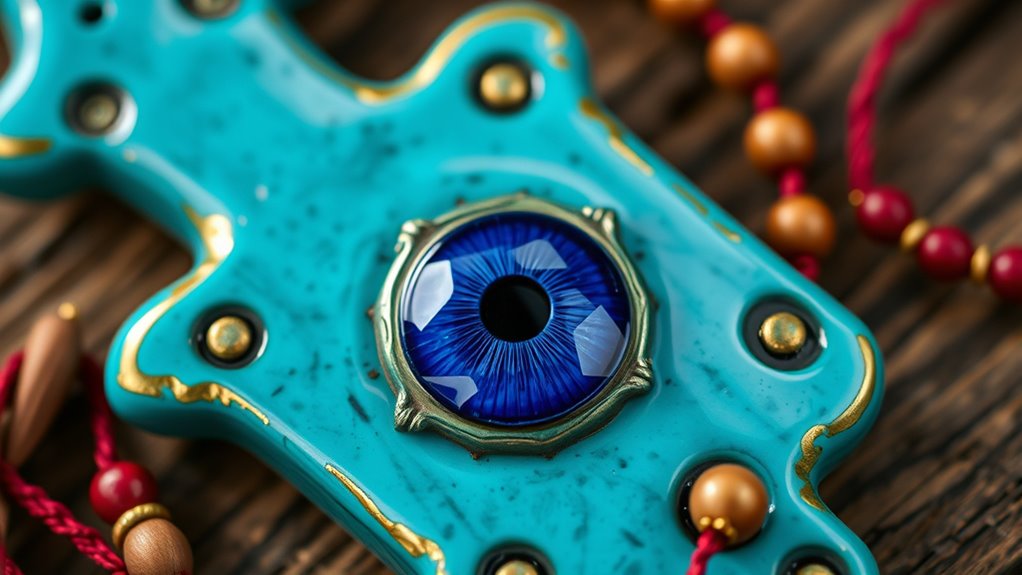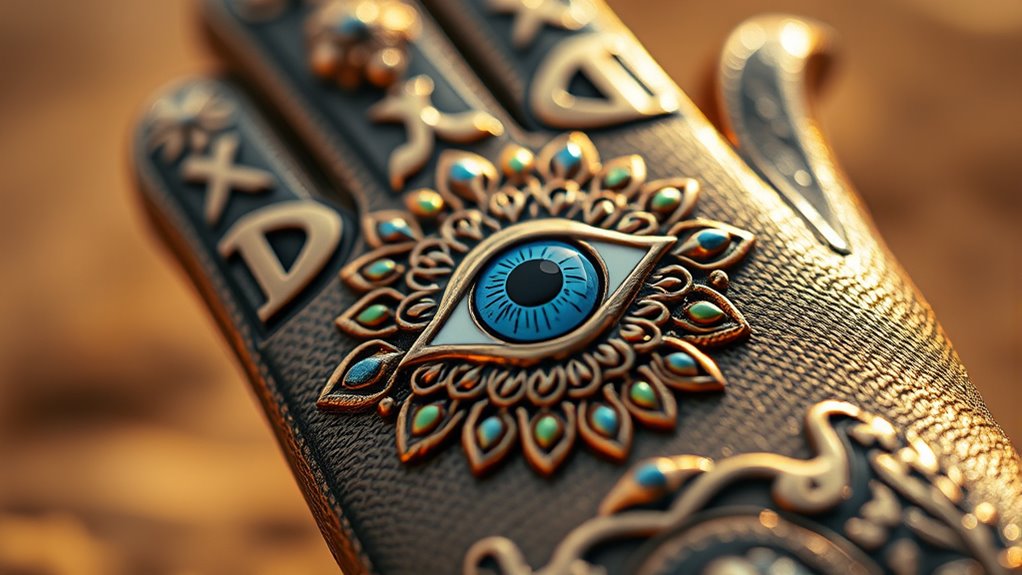The Hamsa symbol’s rooted in ancient cultures, designed to ward off the evil eye and protect you from negativity. Known as the Hand of Fatima or Miriam, this powerful amulet brings good fortune and divine safeguarding. When worn as jewelry or placed in your home, its intricate designs not only enhance beauty but also act as a protective talisman. Discover how the Hamsa can enrich your life and explore various cultural interpretations and practical uses for your own protection.
Key Takeaways
- The Hamsa symbol, also known as the Hand of Fatima, serves as a protective talisman against the evil eye and negative energy.
- Incorporating the evil eye motif within Hamsa designs enhances its protective qualities against harmful gazes and envy.
- Wearing Hamsa jewelry provides constant protection and serves as a reminder of positive intentions in daily life.
- Strategically placing Hamsa symbols in homes helps deflect negativity and safeguard the inhabitants from unwanted attention.
- Reciting prayers or phrases while using the Hamsa amplifies its protective effects against the evil eye.
The Origin of the Hamsa Symbol

The Hamsa symbol, often recognized for its distinctive hand shape, has deep roots in ancient history. Originating in ancient Mesopotamia, it’s linked to powerful goddesses like Inanna and Išhtar, representing love and strength.
In Carthage, it symbolized deities like Tanit, associated with fertility and lunar cycles. You’ll find the earliest Hamsa depictions dating back around 2,000 years, mainly across the Middle East and North Africa.
As cultures evolved, the Hamsa shifted through Phoenician and Islamic traditions, gaining significance as Fatima’s hand. In various contexts, it serves as a protective amulet, warding off malevolent forces.
This symbol’s rich history showcases its enduring role across diverse cultures and faiths, reflecting humanity’s quest for protection and spiritual connection.
Understanding the Evil Eye

Understanding the evil eye involves delving into a fascinating belief that spans cultures and centuries. This supernatural concept suggests that a person’s envious gaze can inflict harm on others, leading to misfortune or illness.
You might notice symptoms like loss of appetite, excessive yawning, or even vomiting if you believe you’ve been affected. The evil eye belief isn’t just personal; it echoes societal fears of unwanted attention and envy.
Many cultures have developed protective symbols, such as the hamsa or the evil eye amulet, to deflect these negative energies. These symbols often feature blue, thought to offer additional protection.
Ultimately, the belief in the evil eye highlights the psychological impact of envy and the need for vigilance against negative emotions.
Cultural Significance of Hamsa and Evil Eye

While many cultures have their own interpretations, the Hamsa and the Evil Eye hold profound significance across various traditions.
Known as the “Hand of God,” the Hamsa symbolizes divine protection and good fortune, deeply rooted in Islamic and Jewish practices, often called the “Hand of Fatima” or “Hand of Miriam.” You’ll find it in homes, safeguarding inhabitants from negativity.
In Hinduism and Buddhism, the Hamsa represents spiritual concepts, emphasizing its universal appeal. Variations of the symbol, like the eye at its center, enhance its protective qualities.
Today, the Hamsa remains a popular amulet in jewelry and home decor, embodying love, happiness, and blessings while warding off the Evil Eye across cultures.
Protection Techniques With Hamsa and Evil Eye

Hamsa and Evil Eye symbols offer practical protection techniques that help safeguard against negative energies. You can wear amulets featuring these symbols for constant protection, whether as jewelry or clothing.
The Hamsa often incorporates an eye symbol, acting as a talisman against negativity. Placing these symbols in strategic locations around your home can deflect negativity and attract positivity. Reciting specific phrases or prayers enhances their protective effects.
Gestures like extending five fingers help ward off negative energies, especially when receiving praise. Combining the Hamsa with the Evil Eye creates a more powerful amulet, balancing energies.
Variations Across Cultures

As you explore the variations of the Hamsa and Evil Eye across cultures, you’ll discover how these symbols have adapted to different beliefs and traditions.
The Hamsa, with roots in ancient Mesopotamia, symbolizes divine protection and good fortune. In Islam, it often includes Quranic verses, while Judaism employs it as an amulet with Hebrew texts.
Even Christianity has embraced the Hamsa, albeit less commonly. In Buddhism, the five fingers represent moral precepts, and in Hinduism and Jainism, it symbolizes life and divine safeguarding.
You’ll notice common design elements like the central eye, fish, and floral motifs, all enhancing its protective nature. Today, the Hamsa remains a beloved emblem in diverse cultures worldwide.
Spiritual Significance and Awareness

Recognizing the spiritual significance of the Hamsa can deepen your understanding of its role in various cultures. This powerful amulet protects against the evil eye, a negative force believed to bring misfortune.
You’ll find that the Hamsa symbolizes divine intervention, acting as a shield against harmful energies. In Judaism, it represents divine protection, while in Buddhism and Hinduism, its fingers connect to different elements and chakras, promoting energy balance.
Each finger emphasizes the importance of using your senses in devotion. The eye motif deflects negativity, making the Hamsa a universal symbol of protection.
Whether worn as jewelry or displayed at home, it fosters spiritual awareness and shields you from unseen dangers, attracting positivity into your life.
Historical Development of the Symbols

While exploring the historical development of the Hamsa symbol, you’ll find its origins trace back to ancient Mesopotamia, where it was closely associated with goddesses like Inanna and Išhtar.
Recent discoveries indicate its use began around 1500 BC. The Carthaginians, influenced by Phoenician culture, adopted the symbol around 800 BC as an amulet for protection, similar to the goddess Tanit.
Across various Semitic cultures and ancient Egyptian civilizations, the Hamsa consistently represented divinity and protection. Despite its cultural variations, the open right hand remained a universal sign of safeguarding.
The symbol evolved, often embellished with designs, and was utilized in jewelry and art, reflecting its enduring significance in offering protection against misfortune throughout history.
Practical Uses in Daily Life

Incorporating the Hamsa into your daily life can transform your environment into a sanctuary of protection and positivity.
Hang a Hamsa near your front door to ward off negative energies and welcome guests with peace. Placing one in your bedroom or office can create a serene atmosphere, acting as your personal guardian.
You might also consider using a Hamsa as a door knocker, adding both style and a protective element. In your personal accessories, wearing Hamsa jewelry keeps that protective energy close.
Whether you meditate with it or carry a small amulet in public spaces, the Hamsa invites positivity and reassures you throughout your day, enhancing both your home and spirit.
Crafting Your Own Personal Talismans

Crafting your own Hamsa talismans allows you to personalize your protective symbols and infuse them with your unique energy.
Start with materials like Delica beads, beading thread, and a size 10 needle to create intricate designs using brick stitch patterns. If you prefer a different approach, try wrapping aluminum foil around cardboard templates for a modern look. Air purifiers can also enhance your crafting environment by ensuring clean air while you work. Consider using sustainable materials like recycled plastics to align your crafting with eco-friendly practices. Additionally, using color accuracy in your designs can enhance the visual appeal of your talismans, making them more striking.
You can also use textiles or felt, incorporating embroidery techniques for added texture. Consider integrating the evil eye symbol for enhanced protection and choose colors with spiritual significance.
Don’t forget to set clear intentions while crafting, as this will activate your talisman’s protective power. Regularly cleanse and recharge your creation to keep its energy strong. Additionally, exploring effective workflow can enhance your crafting process, ensuring that you create with focus and intention.
Frequently Asked Questions
Can I Combine Hamsa and Evil Eye in Jewelry?
Absolutely, you can combine the Hamsa and Evil Eye in jewelry!
Wearing them together enhances their protective energies, creating a powerful shield against negativity. You can find them as necklaces, bracelets, or earrings, and even layer them for added effectiveness.
This combination not only looks beautiful but also symbolizes a holistic form of protection.
How Do I Cleanse My Hamsa or Evil Eye?
Imagine your jewelry as a garden, needing care to flourish.
To cleanse your Hamsa or evil eye, soak it in moon water, letting the night’s glow wash away negativity. You could also bathe it in saltwater, purifying its essence.
Light some sage and let the smoke wrap around it, inviting fresh energy.
Regularly setting intentions while visualizing positivity keeps your jewelry vibrant, ensuring it remains a protective talisman in your life.
Is There a Specific Color for Hamsa?
When it comes to Hamsa, there’s no single color that defines it, as colors can vary based on personal preference and cultural significance.
You might find traditional hues like blue and white, symbolizing protection and purity.
Alternatively, modern designs feature a broader palette, including shades like dark cerulean and lapis lazuli.
Ultimately, choose colors that resonate with you, reflecting your style and the protective qualities you seek in your Hamsa.
Can Children Wear Hamsa or Evil Eye Jewelry?
Yes, children can wear Hamsa or Evil Eye jewelry. Many cultures embrace these symbols as protective charms for kids, helping shield them from negative influences and bad intentions.
Wearing this jewelry often connects children to their cultural roots and traditions. The delicate designs available make them perfect for young ones, and they can boost a child’s confidence and self-esteem.
Plus, it’s a great opportunity for parents to teach kids about cultural heritage.
Are There Any Rituals to Enhance Their Protective Power?
To enhance the protective power of your amulets, consider engaging in blessing rituals. You can set intentions focused on protection while holding the charm.
Specific prayers or meditations might also amplify its potency. Displaying the amulet prominently serves as a constant reminder of its protective qualities.
Additionally, combining it with other protective symbols could further strengthen its energy, making you feel more secure in your surroundings. Trust in its power, and it’ll serve you well.
Conclusion
In embracing the Hamsa and the Evil Eye, you’re not just wearing symbols; you’re donning a shield against negativity and fear. These ancient emblems weave a tapestry of hope and protection in your life, reminding you that light can triumph over darkness. So, as you craft your own talisman, remember: every stroke, every bead, serves as a powerful affirmation of your strength and resilience, inviting positivity to flow freely into your world.









